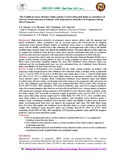The Umbilical Artery Resistive Index and the Cerebro-Placental Ratio as a Predictor of Adverse Foetal Outcome in Patients with Hypertensive Disorders of Pregnancy during Third Trimester.

View/
Date
2013Author
Parmar, LP
Mwango, GN
Wambugu, MN
Ong’ech, JO
Type
ArticleLanguage
enMetadata
Show full item recordAbstract
Background: Hypertensive disorders of pregnancy causes adverse effects both the maternal and faetal circulations. These circulations can be assessed safely and non-invasively by Doppler `ultrasound using arterial Doppler indices of umbilical artery alone or combining the umbilical
artery with the middle cerebral artery thus attaining the cerebroplacental ratio (ratio of the middle cerebral artery resistive index over that of the umbilical artery). The main objective of this study was to compare the Umbilical Artery Resistive index alone and the cerebroplacental ratio as a predictor of adverse fetal outcome in patients with hypertensive disorders of pregnancy in third trimester.
Methods: A prospective cohort study was carried out at the Kenyatta National Hospital (KNH) over a period of nine months. Gravid patients at least 32 weeks gestations by dates were recruited from labor ward. Consecutive sampling method was used. The Umbilical Artery Resistive Index was obtained and the cerebroplacental ratio was also calculated from the Umbilical Artery Resistive Index and Middle Cerebral Artery Resistive index.
Results: A total of 160 patients were recruited into the study. Among neonates of mothers with pregnancy induced hypertension with Umbilical Artery Resistive Index median (0.64), a fetal birth score < 7 was 0.5 (95% CI 0.3, 0.8; p <0.001) times more likely than a score > 7 and 6.6 (Odds Ratio 6.6; 95% CI 2.5, 17.3; p <0.001) times more likely relative to hypertensive mothers with Umbilical Artery Resistive Index > median (0.64). Combining Umbilical Artery Resistive Index and Middle Cerebral Artery Resistive Index (cerebroplacental ratio) improves the prognostic odds ratio from 6.6 to 82. The Umbilical Artery Resistive Index (/> median) had 80% (95% CI 63%, 90%) sensitivity, 62.3% (95% CI 54%, 70%) specificity, 33% positive predictive value, and 93.1% negative predictive value for neonatal adaption after birth as seen from the foetal birth score. Among infants of mothers with hypertensive disorder during pregnancy with Umbilical Artery Resistive Index median (0.64), low birth weight (<10th percentile of expected weight at gestation week) was 0.5 (95% CI 1.9, 7.3) times more likely than normal weight and 9.5 (Odds Ratio 9.5; 95% CI 3.1, 29.2; p<0.001) times more likely relative to infants of hypertensive mothers with Umbilical Artery Resistive Index > median (0.64). Combining Umbilical Artery Resistive Index and Middle Cerebral Artery Resistive Index (cerebroplacental ratio) does not improve the prognostic odds ratio. The Odds Ratio drops from 9.5 to5.6. This implies the Umbilical Artery Resistive Index is a better predictor of low birth weight. The Umbilical Artery Resistive Index (/> median) had 85.2% (95% CI 67.5%, 94%) sensitivity, 62.4% (95% CI 54%, 70%) specificity, 31.5% positive predictive value, and 95.4% negative predictive value for abnormal birth weight.
Conclusion • The Cerebroplacental ratio is a better predictor of faetal birth score < 7 as compared to Umbilical Artery Resistive Index.
• The Umbilical Artery Resistive Index is a better predictor of low birth weight as opposed to cerebroplacental ratio.
• Both cerebroplacental ratio and Umbilical Artery Resistive Index can be used in combination to get the best results on faetal birth score and foetal weight.
Citation
East and Central African Journal of Surgery Vol 18, No 3 (2013)Collections
- Faculty of Health Sciences (FHS) [10387]
